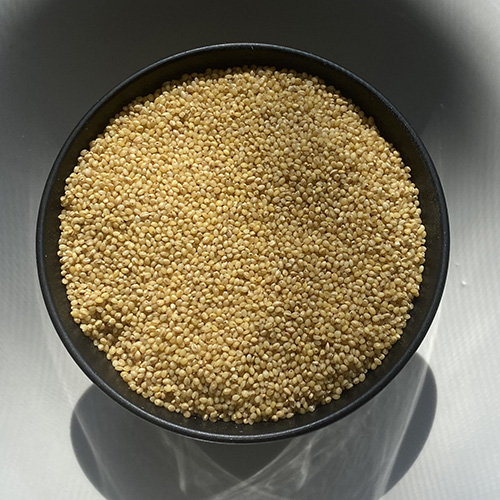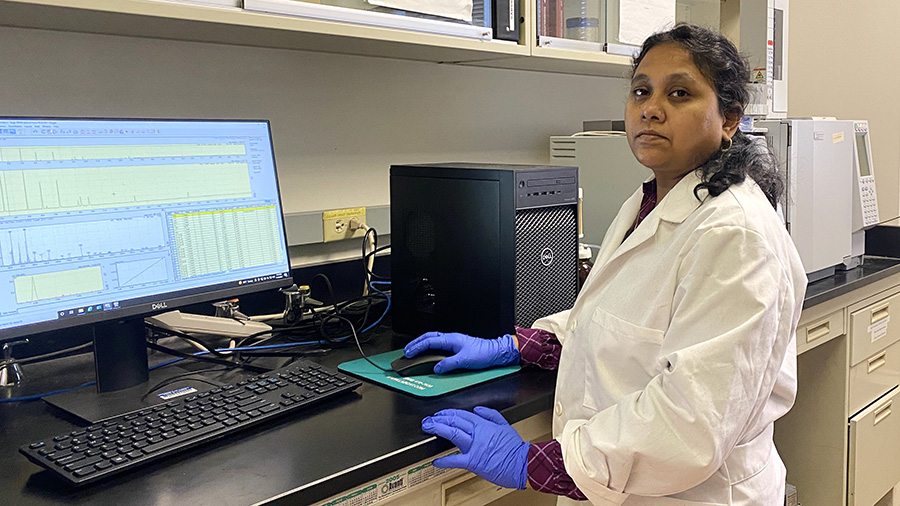
Mining millets
Millets are ancient grains and cereals with origins in Africa, the Middle East and Asian countries including China and India, where they are food staples. In addition to growing in harsh environments and enduring drought or attacks by pests, millets are often less processed and yield higher nutritional benefits than grains such as corn, rice and wheat.

Those conventional grains of the Western diet are well studied, but scientists know little about the bioactive food species in major and minor millets, including the distribution of lipids, or fat-soluble compounds; the composition of fatty acids, or lipid building blocks; and the presence of nutraceuticals, or substances in millets and food that benefit physiological health.
Sugasini Dhavamani, a research assistant professor at the University of Illinois at Chicago, and her team have studied the nutri-lipidomic profiles of major and minor millet seeds and oils.
“I am passionate about lipid research,” Dhavamani said, “I love working at the University of Illinois because we have amazing equipment and facilities, and great means for collaboration.”
The oils of grains are not commercially available, so the researchers first extracted lipids from the millets, then analyzed samples using high-performance liquid chromatography and gas chromatography-mass spectrometry.
“The oil extraction takes time,” Dhavamani said, adding that the researchers face other challenges. “After extraction we often get a low quantity of lipids, which can also cause difficulty. Stability is a concern because the lipids are easily oxidized.”

After profiling sorghum millet, little millet, finger millet, proso millet, kodo millet, pearl millet and foxtail millet, Dhavamani and colleagues found that oleic acid, linoleic acid and alpha-linoleic acid, or omega-9,-6 and -3, are the three major fatty acid species present in millets and seed oils.
“Most of the millets evaluated contained omega-9 and omega-6 and a small amount of omega-3 fatty acids, which help to lower cholesterol and blood pressure levels, and can benefit chronic disease,” Dhavamani said. “Millets also have nutraceuticals, which are helpful for lowering inflammation.”
In the future, the researchers want to expand this work into animal models, where Dhavamani can assess the health benefits of millet consumption, followed by examining proteomics and metabolomics of millets; however, experiments of this scale require increased funding.
Details
Sugasini Dhavamani will present this research from 5:30 to 6:30 p.m. CDT on Sunday, March 24, at Discover BMB 2024, the American Society for Biochemistry and Molecular Biology annual meeting in San Antonio. Her poster will be at board 326.
Abstract title: Nutri-lipidomics, bioactive lipids and antioxidant potential of major and minor millet seed and oil — a novel approach
Enjoy reading ASBMB Today?
Become a member to receive the print edition four times a year and the digital edition monthly.
Learn moreGet the latest from ASBMB Today
Enter your email address, and we’ll send you a weekly email with recent articles, interviews and more.
Latest in Science
Science highlights or most popular articles

Mining microbes for rare earth solutions
Joseph Cotruvo, Jr., will receive the ASBMB Mildred Cohn Young Investigator Award at the ASBMB Annual Meeting, March 7–10, just outside of Washington, D.C.

Fueling healthier aging, connecting metabolism stress and time
Biochemist Melanie McReynolds investigates how metabolism and stress shape the aging process. Her research on NAD+, a molecule central to cellular energy, reveals how maintaining its balance could promote healthier, longer lives.

Mapping proteins, one side chain at a time
Roland Dunbrack Jr. will receive the ASBMB DeLano Award for Computational Biosciences at the ASBMB Annual Meeting, March 7–10, just outside of Washington, D.C.

Exploring the link between lipids and longevity
Meng Wang will present her work on metabolism and aging at the ASBMB Annual Meeting, March 7-10, just outside of Washington, D.C.

Defining a ‘crucial gatekeeper’ of lipid metabolism
George Carman receives the Herbert Tabor Research Award at the ASBMB Annual Meeting, March 7–10, just outside of Washington, D.C.

The science of staying strong
Muscles power every movement, but they also tell the story of aging itself. Scientists are uncovering how strength fades, why some species resist it and what lifestyle and molecular clues could help preserve muscle health for life.

